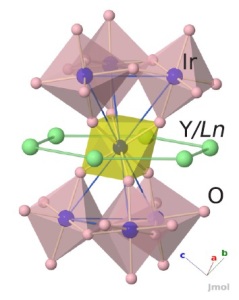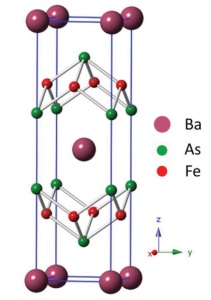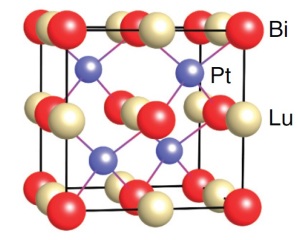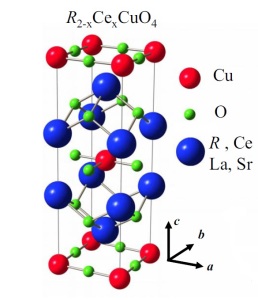Pyrochlore Iridates
A combination of geometric frustration, intermediate correlations, strong spin-orbit interactions, local f moments, and itinerant d-electrons in these complex materials gives rise to their rich physics. By decreasing the size o f the rare earth element in the chemical composition of pyrochlore iridates R their electric transport behavior varies from the insulator to metal as a result of bond angle tuning. I have shown the same insulator to metal transition in one of these compounds Eu2Ir2O7 using hydrostatic pressure as the tuning parameter. Eu2Ir2O7 has a metal to insulator transition (MIT) at Tc = 115 K at ambient pressure. As I have increased the pressure, using a diamond anvil cell, this metal to insulator transition temperature shifted down and eventually vanished at a critical pressure Pc = 6 GPa where an insulator to metal quantum phase transition has occurred. One of the intriguing aspects of this transition is that while the insulating gap (25 meV) closes under pressure at Pc, the MIT transition temperature Tc does not change with pressure. The high-pressure semimetal may be the Weyl phase which is a topological semimetal with an even number of Dirac cones. Weyl fermions are the solution to the Dirac equation with zero mass. Since the number of Dirac points in the first Brillouin zone of a Weyl semimetal (WSM) is even, it can break time-reversal symmetry which is not allowed in topological insulators with an odd number of Dirac points.
f the rare earth element in the chemical composition of pyrochlore iridates R their electric transport behavior varies from the insulator to metal as a result of bond angle tuning. I have shown the same insulator to metal transition in one of these compounds Eu2Ir2O7 using hydrostatic pressure as the tuning parameter. Eu2Ir2O7 has a metal to insulator transition (MIT) at Tc = 115 K at ambient pressure. As I have increased the pressure, using a diamond anvil cell, this metal to insulator transition temperature shifted down and eventually vanished at a critical pressure Pc = 6 GPa where an insulator to metal quantum phase transition has occurred. One of the intriguing aspects of this transition is that while the insulating gap (25 meV) closes under pressure at Pc, the MIT transition temperature Tc does not change with pressure. The high-pressure semimetal may be the Weyl phase which is a topological semimetal with an even number of Dirac cones. Weyl fermions are the solution to the Dirac equation with zero mass. Since the number of Dirac points in the first Brillouin zone of a Weyl semimetal (WSM) is even, it can break time-reversal symmetry which is not allowed in topological insulators with an odd number of Dirac points.
Iron-based superconductors
Discovering universal trends that do not depend on details of a specific material are of great importance in condensed matter physics. I have discovered a universal V-shaped phase diagram for the pressure dependence of the superco nducting transition temperature Tc in AFe2As2 where A could be any of the Alkali metals: K, Rb, or Cs. As a function of pressure, Tc in AFe2As2 decreases initially until a critical pressure Pc, where it reverses direction and increases. Pc = 17.5 and 14 kbar for A = K, Rb, and Cs. Comparing the V-shaped pressure dependence of Tc in these three materials reveals a universal trend in which and are identical in AFe2As2 independent of the chemical composition and the structural parameters. My interpretation for the Tc reversal at Pc in AFe2As2 is a change of pairing state induced by pressure since the normal state properties such as inelastic scattering rate and the Hall coefficient do not show any abrupt anomaly as they pass through the critical pressure, this phase transition is most probably a change in the pairing symmetry of the superconductor.. Several recent theoretical works proposed close competition between d-wave and s-wave pairing in these fully hole-doped AFe2As2 systems. Our serial pressure experiments provide firm experimental ground to support these ideas. I also examined the pressure dependence of the critical field Hc2 in both RbFe2As2 and KFe2As2 and found a second universal property of the transition: a two-fold jump in the quantity at Pc in both compounds. Based on recent theoretical works, this quantity depends on the Fermi velocity and the gap structure. Hall effect measurements rule out any sudden changes of the Fermi surface parameters at Pc. Therefore, the two-fold jump originates from a change of the gap structure. I proposed that the transition at Pc is from a d-wave state to a sign-changing s-wave state. The universal features of this transition make it a generic feature of the alkali 122 iron pnictides. While it is widely accepted that multiband superconductivity is at the mercy of material specific parameters, our finding of universal features clearly challenges the current status quo.
nducting transition temperature Tc in AFe2As2 where A could be any of the Alkali metals: K, Rb, or Cs. As a function of pressure, Tc in AFe2As2 decreases initially until a critical pressure Pc, where it reverses direction and increases. Pc = 17.5 and 14 kbar for A = K, Rb, and Cs. Comparing the V-shaped pressure dependence of Tc in these three materials reveals a universal trend in which and are identical in AFe2As2 independent of the chemical composition and the structural parameters. My interpretation for the Tc reversal at Pc in AFe2As2 is a change of pairing state induced by pressure since the normal state properties such as inelastic scattering rate and the Hall coefficient do not show any abrupt anomaly as they pass through the critical pressure, this phase transition is most probably a change in the pairing symmetry of the superconductor.. Several recent theoretical works proposed close competition between d-wave and s-wave pairing in these fully hole-doped AFe2As2 systems. Our serial pressure experiments provide firm experimental ground to support these ideas. I also examined the pressure dependence of the critical field Hc2 in both RbFe2As2 and KFe2As2 and found a second universal property of the transition: a two-fold jump in the quantity at Pc in both compounds. Based on recent theoretical works, this quantity depends on the Fermi velocity and the gap structure. Hall effect measurements rule out any sudden changes of the Fermi surface parameters at Pc. Therefore, the two-fold jump originates from a change of the gap structure. I proposed that the transition at Pc is from a d-wave state to a sign-changing s-wave state. The universal features of this transition make it a generic feature of the alkali 122 iron pnictides. While it is widely accepted that multiband superconductivity is at the mercy of material specific parameters, our finding of universal features clearly challenges the current status quo.
Half-Heuslers
Half-Heusler compounds have been long known for their thermoelectric properties. They have a simple XYZ composition and their band structure is beautifully tunable from the insulator to semimetal, to metal, to a superconductor. Recently, they have been proposed as candidate topological insulators and superconductors. The spin-orbit coupling can be boosted in these systems by choosing heavy elements such as Pt and Bi as the chemical constituents of their 111 ternary compositions. Superconductivity has been discovered in two members of this family: LaPtBi and YPtBi. I have discovered superconductivity in LuPtBi which has the maximum spin-orbit coupling strength, hence the most promising candidate for topological superconductivity amongst these band inverted semimetals. LuPtBi is also a noncentrosymmetric superconductor, similar to CePt3Si and CeIrSi3, except LuPtBi does not have any free f-electrons. To learn more about this work please click here.
Cuprates
Understanding the organizing principle in the phase diagram of high-temperature superconductors is a question of recognized importance. Surprisingly, we still do not have a clear understanding as to why Tc has a dome-lik e doping dependence? A dominant view in the field is that the Tc dome is the manifestation of strong phase fluctuations on the underdoped side of the cuprate phase diagram. In this picture, the pairing strength and the upper critical field Hc2 continue to increase by underdoping but Tc decreases and forms a dome due to strong phase fluctuations that prevent long-range coherence in an otherwise paired electron fluid. I put this idea to scrutiny through a careful quantitative analysis of the superconducting fluctuations in the Nernst effect of the electron-doped cuprate PCCO. My observations contradict the phase fluctuation scenario and present a different explanation for the dome-like doping dependence of Tc: a scenario of phase competition. In the “phase competition” scenario, the decline of Tc by underdoping is due to the decrease of pairing strength as a result of competition between superconductivity and another order – in this case, antiferromagnetism. This hypothesis has three major consequences: first, a quantum critical point must exist at T = 0 separating the two different ground states that compete; second, superconducting fluctuations must be present in overdoped samples as well as in underdoped samples and must have a similar nature on both sides of the Tc dome; third, the upper critical field must decrease by underdoping as a result of diminishing pairing strength.
e doping dependence? A dominant view in the field is that the Tc dome is the manifestation of strong phase fluctuations on the underdoped side of the cuprate phase diagram. In this picture, the pairing strength and the upper critical field Hc2 continue to increase by underdoping but Tc decreases and forms a dome due to strong phase fluctuations that prevent long-range coherence in an otherwise paired electron fluid. I put this idea to scrutiny through a careful quantitative analysis of the superconducting fluctuations in the Nernst effect of the electron-doped cuprate PCCO. My observations contradict the phase fluctuation scenario and present a different explanation for the dome-like doping dependence of Tc: a scenario of phase competition. In the “phase competition” scenario, the decline of Tc by underdoping is due to the decrease of pairing strength as a result of competition between superconductivity and another order – in this case, antiferromagnetism. This hypothesis has three major consequences: first, a quantum critical point must exist at T = 0 separating the two different ground states that compete; second, superconducting fluctuations must be present in overdoped samples as well as in underdoped samples and must have a similar nature on both sides of the Tc dome; third, the upper critical field must decrease by underdoping as a result of diminishing pairing strength.

